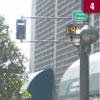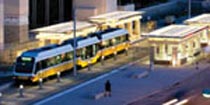Amid much excitement, the first section of Dallas Area Rapid Transit’s (DART‘s) newest line, the Green line, opened on September 14, 2009. The Green line joins DART‘s successful light rail network that also includes the Red and Blue lines. Along with excitement, the Green line brings a challenge to the entire DART network — an increase in train traffic through downtown Dallas.
This section of the Green line runs from just north of downtown to MLK station at Fair Park. In total, five new stations have opened with this first section of the Green line. However, through downtown the Green line uses the existing Red and Blue line tracks and makes stops at the existing stations. Maximum train headways through the downtown transit mall increased from 18 trains per hour to 24 trains per hour in each direction during peak travel times.
To handle this 33 percent increase, DART and the City of Dallas have developed and deployed a new Transit Signal Priority (TSP) system, which will now track trains in the network. The Texas Transportation Institute (TTI) was asked to provide technical and oversight support for this task.
“TTI was a critical component to the success of this project,” states DART Director of Operations Technology Abed Abukar. “They provided the technical expertise and necessary oversight that kept the project team focused solely on meeting the end goals.”
According to Abukar, the TSP project could not have been a success without TTI‘s expertise and the City of Dallas’ willingness to work alongside DART.
The new TSP system was designed to detect train locations as they travel through the downtown area. The system is comprised of four components: a train detection system, a communications system, traffic signal logic and peer-to-peer messaging. Working together these components provide nonstop station-to-station travel for DART trains while maintaining the current vehicular street traffic level of service.
If designing these components to work cohesively as one system wasn’t challenging enough, coordinating deployment activities and testing the system lurked right around the bend. Full-scale testing of a system that involves passengers and runs on a schedule is difficult to do in advance. To help test the system, a simulation model was developed by TTI that can test the system at its expected capacity of 24 trains per hour in each direction. It will also give DART the capability to simulate future changes to the TSP logic to assess their impact without affecting service trains and vehicular traffic.
“The simulation model TTI built proved to be helpful,” explains Abukar. “Testing the system with multiple scenarios and variables allowed us to fully stress the system, which in turn showed us any deficiencies it had before it was launched.”
While light-rail systems present their own challenges, they are being increasingly looked at as a solution that improves mobility and air quality, bolsters economies and provides an overall better quality of life.
“A collaborative effort between DART and the City of Dallas is making DART‘s light-rail system both innovative and successful,” states TTI Research Scientist Roberto Macias. “The expansion of this light-rail network and advanced TSP system offers other cities considering light-rail transit a blueprint for success.”





The photos above highlight multiple components of the TSP system; each component performs a specific role within the system to help DART trains move through downtown efficiently and quickly and also help pedestrian and vehicular traffic flow smoothly. (1) Infrared presence detector at St. Paul station; (2) Magnetometer detector embedded in pavement bricks; (3) Infrared presence detector at intersection; (4) Train countdown timer at stations; and (5) 5.8 GHz wireless communication radios.

